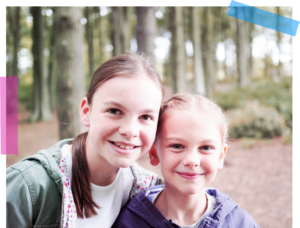A Tale of Two Sisters (Part 1)

I have had nosebleeds ever since I was 5 years old. These nosebleeds aren’t your normal nosebleeds – I get them every day, sometimes more than once a day. On January 31, 2020, I was diagnosed with a very rare genetic condition called Hereditary Hemorrhagic Telangiectasia (HHT for short). I had lots of tests to find out why and an operation I had in February 2019 on my nose proved that I had lots of tiny blood vessels in my nose (called telangiectasia) that was causing the nosebleeds. I had to have more tests, including blood and DNA, to find out why the blood vessels had formed.
My blood vessels sometimes go crazy and create too many little ones (telangiectasia) which bleed easily, like in my nose or on my skin. I have a little mark on my cheek which is a telangiectasia. I’ve been told, I grow up more of these will form on my hands and they might even bleed like my nose. The other thing the blood vessels can be is “lazy” and take short cuts when they form so instead of arteries going into capillaries and then back into veins, they take a shortcut and the vein, and the artery connect directly. It’s like a tree with no twigs or roots which means they can’t pick up the essentials, and my blood doesn’t slow down, so I can get clots.
They treat my nosebleeds by an operation. I was the first child in the country to have a new type of operation on July 7, 2020. They blast my nose with particles, and it shrinks the vessels. Now, I must have this operation every 12 weeks. Hopefully, the time between the operations will become greater the more I have.
The version of HHT that I have is the ENG gene, this type mostly likely creates the lazy vessels, called AVMs (arteriovenous malformations) in my lungs. During some tests for my third nose operation, my doctor noticed that my oxygen count was low. They did some more tests and saw that I have pulmonary arteriovenous malformations (PAVMs) even though I am only 11. I currently have 3 PAVMs. This means that when my blood travels through my lungs to collect oxygen, because of the short cut it can’t collect the oxygen, so I don’t have enough oxygen in my blood. I become breathless more often than normal. It is a nuisance, but there is something more serious because the blood could form a clot. If the clot travels to vital parts in my body a very serious problem could happen– a stroke (which is when part of my brain doesn’t get oxygen, so it stops working)!

I am going to have an operation to block off the AVMs. They will feed a bit of wire from my leg, through the veins up to my lung AVMs. Once they find them, they will feed a bit of material and then this will be a roadblock to the shortcut. One of my AVMs is easy to reach. The second is a bit trickier but possible. The third is a real challenge, and my surgeon, Dr. Crossland, doesn’t know if he can reach it safely, but he will have a go. The operation is risky, but if I don’t have the operation there would be a greater risk for more serious problems. Once they have blocked these PAVMs, it doesn’t mean that more won’t form. I could continue to get more or, possibly, never get another one again! In the meantime, it will be important for me to have follow-up scans to check if more grow.
One of the other places I could form an AVM is in my brain. If this happens and the AVM starts to swell (this is called an aneurysm), it could stop the signals in my brain. Without screening, I would only know if I have a brain AVM if it starts to swell and at that point it could be life-threatening. Some part of my body might stop working or I could get a bad headache that makes me sick or I could start to see flashing lights. This is serious, so I have decided to have an MRI scan of my brain to know if there are any hiding. If there are, the doctors might not be able to do anything about them, but I’d rather know about them than play the waiting game and wonder if anything is there. Only 10 people in 100 HHT patients get a brain AVM, so it’s a low chance I’ll get one. Brain AVMS don’t grow as easily as lung ones, so I won’t have to have as many scans–maybe just one again once I am an adult.
In the last year I have learned a lot about the human body, and it has been interesting but also hard to know that everyday could bring something new and a little scary. Living with HHT makes me feel nervous because it’s living with lots of possibilities and I never know what’s coming around the corner. It might be a little nosebleed or a massive nosebleed, a spot appearing on my hands, some breathlessness, or a headache, or none of them!
I am writing this so that my friends and family understand what is happening to me. Sometimes, learning more about my body and all the ways I am different because of HHT is fascinating. Other times, it’s a bit upsetting and I just want to be the same as others and not have to go through it all. It’s all just a big game of never-ending hide and seek—but not the fun kind you play with your friends.
Right now, there is no cure for HHT. My sister wants to be a doctor when she is older and her goal is to find a cure, but for now I will have it for the rest of my life. If I have children, there is a 50% chance I will pass it on to them. Luckily, the symptoms are manageable and treatable which is why an HHT diagnosis is so important. Continue to Part 2: Hope >>

Lily you are amazing and so brave. You write brilliantly- must be all that reading!! 😍
Sending tons of positive vibes for next Monday 🤗
Hi Lily! I am happy you found out about HHT at a young age! I did not find out about my nosebleeds until I was in my 30s. I am now in my 70s and I have gone through some difficult times over the last 40 years. Hang in there, learn all you can and stay in touch with curehht to find out about new treatments and medications!
Greetings Lily, Hope, Mom and Dad, We very much appreciate your sharing your HHT journey. I started having nosebleeds at 10 months; my teen years were the worst; had my first of many 20cm hip AVM hemorrhages at 38 years; have micro PAMs; at 53 I was finally diagnosed with HHT. Four hip embolizations (staff called space age crazy glue) at Toronto Western Hospital, and 2 embolizations at University Hospital, Edmonton, Alberta (2018) has really helped with chronic pain, since 1988. You may find more in the International Foundation Newsletter, Direct Connection, Our Stories, Summer 2006. We are so very grateful for the specialists at 4 HHT Internationally approved HHT Centers in Canada, and for the many satellite hospitals/staff.
I too have experienced, that the more I can learn about HHT, the less power and control it has over me. My goal has always been to SAVE LIVES, by helping people with nosebleeds and birthmarks, to find medical help. Blessed Christmas to All, Your HHT Friend, Delaine, Sherwood Park, Alberta